#Six-spot burnet
Text

Gosh, these moths just have one of the most well co-ordinated looks. The popping red. The shiny black that turns blue and green. The fluff that is well groomed. The antennae that are perfectly curled at the ends. A stylish lad.
Six-spot Burnet (Zygaena filipendulae), Ireland
#bugs#insects#bugblr#six-spot burnet#zygaena filipendulae#zygaena#burnet moths#zygaenidae#moths#lepidoptera#animals#photography#wildlife photography
28 notes
·
View notes
Text
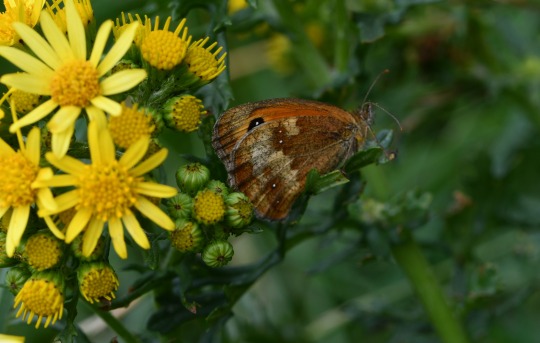
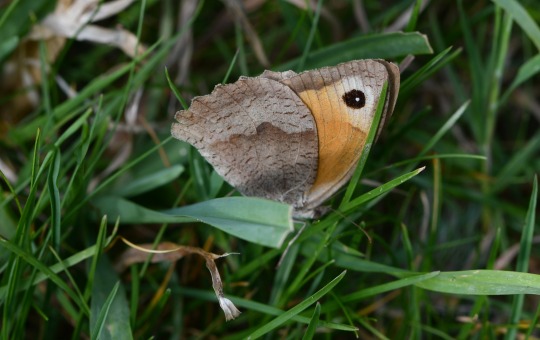

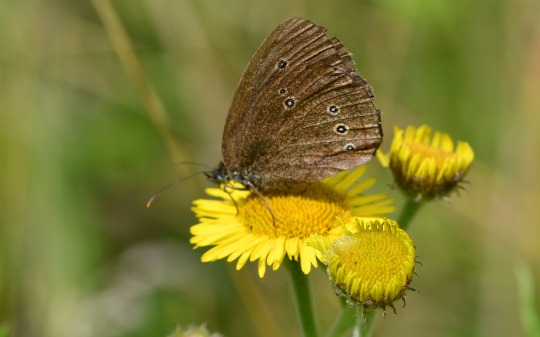
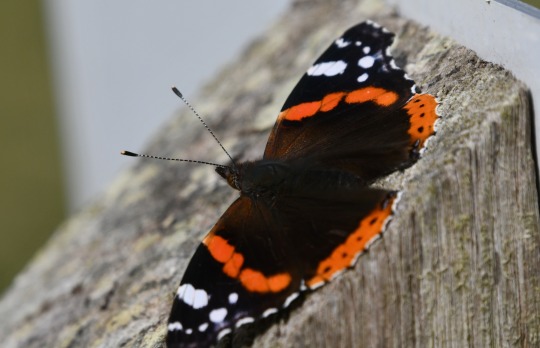
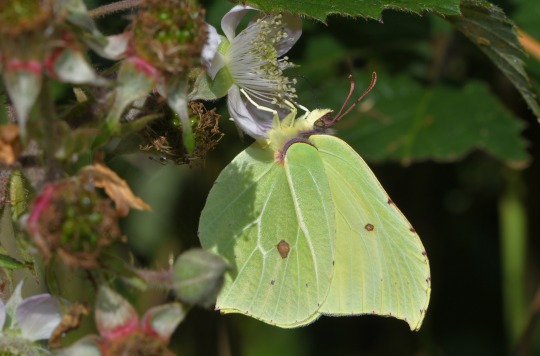
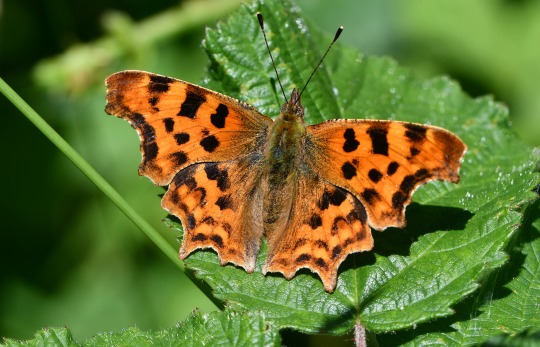
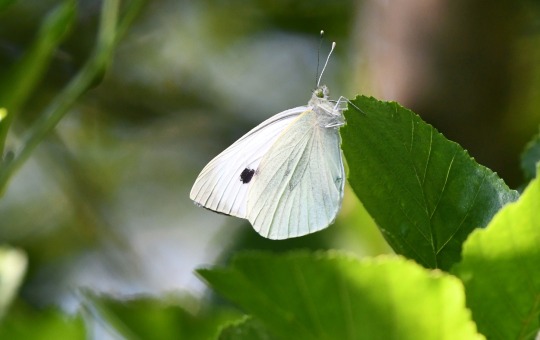
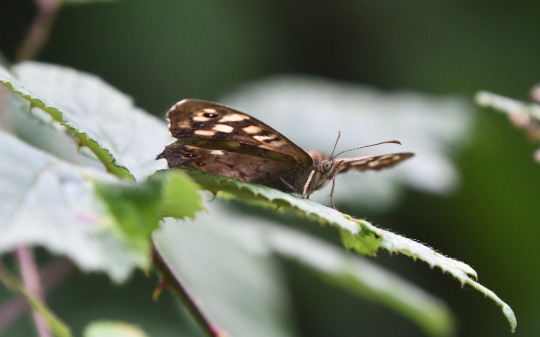
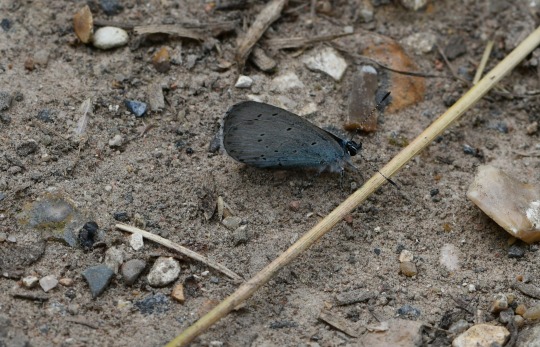
Some thoughts and findings about my contributions to the Big Butterfly Count 2024 and photos from the three weeks
I have well documented over the years my enthusiasm for Butterfly Conservation’s vital summer survey to assess the health of butterfly and day-flying moth populations with since 2020 and working from home allowing constant access to Lakeside Country Park, Eastleigh close to our house meaning I did multiple counts during the survey. Since 2022 at the end of the count just for fun I’ve put all of my results which I keep a written record of after submitting to the count on the days I do them into a spreadsheet and made a leaderboard of the species and amounts I saw overall. It always interests me to look for trends and confirm anything I might have noticed during the counts and this year I thought I’d share some findings. As ever the place I did most counts this year was Lakeside with some in Winchester on office working days too, with visits to Rutland Water for the Global Bird Fair, Durlston in Dorset and visits further afield in/to the edge of Hampshire falling inside the count dates adding a bit of variety.
Overall my top five species in rank order were Meadow Brown, Gatekeeper, Small White, Ringlet and Marbled White and Speckled Wood tied in fifth. This is as predicted and much as I normally get, especially the top two. I do a separate leaderboard just for Lakeside counts which saw Meadow Brown, Gatekeeper, Speckled Wood, Six-spot Burnet and Small White make up my top five. The Lakeside leaderboard not too different to the overall one bar most of my Speckled Woods seen during the count being there and a good year for Six-spot Burnet for me.
The big theme we’ve heard so much of this year and during the count is of course the lack of butterflies and the concern this brings. I started putting my spreadsheet together yesterday morning knowing I’d likely get more counts in before the end of the survey and at that stage my data really reflected the lack of butterflies with 599 butterflies seen with an average of 16.64 per count down from 872 and 20.27 last year. However we then went to the very well managed butterfly haven Stockbridge Down yesterday afternoon and saw clouds of butterflies including my highest ever count for any species in a count of an incredible 80 Meadow Browns. Then today at Perham Down and Shipton Bellinger we saw loads of butterflies especially Meadow Browns with Common Blue and Peacock seeming to increase in numbers in recent days. This late surge pushing my figures up massively to 878 butterflies/moths in total with an average of 20.90 seen per count marginally ahead of last year! I saw 305 butterflies/moths with an average of 19.06 per count in the Lakeside counts compared to 423 and 22.26 last year.
Overall I counted less than last year of ten of the twenty species in the survey. Small White a focal point of the decreasing numbers with only 55 counted this year compared to last year’s 202; yet it only went from second to third in my overall leaderboard which says a lot I think. Red Admiral also a notable decrease but expected after the year with unprecedented numbers of them last year. I didn’t manage to see a single Small Copper in the count and other than a maybe sighting (of possibly seeing one flying very quickly I couldn’t quite tell) I’m yet to see one in Hampshire this year. One Jersey Tiger moth this year as I saw last year meant no increase or decrease for that one species and of the nine that I saw more of in the count overall this year than last most just seem down to chance. The increase in Six-spot Burnet I spotted from last year where I seemed to see more than ever is interesting, in both years particularly seeing lots at Lakeside.
As ever Marbled White and Ringlet which I did see more of than last year is interesting to look at my results for. Initially I put the increase down to the fact they seemed to first emerge in the year later than last year. I have been thinking over the last few years how this key summer pair with relatively short seasons traditionally should be at their peak in the three weeks the Big Butterfly Count is on from July into August, but as the years go by I seem to see my first in a year earlier meaning their seasons are waning with less and eventually none about into the count. Evidence of how the seasons are shifting in our changing world with the butterfly year a bit ahead of itself now. The impact of weather which has led to the troubles for insects this year possibly delaying their emergence a bit to put these two species’ season a bit more into their traditional place, Ringlet in particular I felt I was seeing at Lakeside later into the count than I’m becoming used to. However a check of my year lists this morning revealed the dates I saw my first of the year of them in June didn’t differ greatly to last year actually, in 2023 it just felt they’d been out a little while before I saw my first compared to this year when there seemed to be a lull in insects emerging in June and I first saw these species in a surge of butterfly sightings with some sunny weather. Another possible factor is that without further afield visits west to Martin Down and Durlston where the season seemed a bit behind with particularly Marbled White still out a lot during the count I may not have seen as many.
Purely for my amusement really I also compiled from my regular trip sightings lists a list of other species of butterflies and moths seen out in the day that I spotted during the days I was doing counts and I was pleased to see twenty different species to the ones in the count. Purple Hairstreak, Lulworth Skipper, Small Skipper, Essex Skipper, Silver-spotted Skipper, Large Skipper, Chalkhill Blue, Silver-studded Blue, Silver-washed Fritillary, Dark Green Fritillary, Small Heath, Wall Brown, Common Grayling, Mint moth and my first ever Magpie moths and Purple Bar among the highlights.
The photos in this set are of; Gatekeeper, Meadow Brown and Peacock at Stockbridge Down, Ringlet at Lakeside, Red Admiral at Egleton, Rutland Water, Brimstone and Comma at Martin Down and Large White, Speckled Wood and Holly Blue at Lakeside.
#photography#butterflies#small skipper#peacock#red admiral#comma#small tortoiseshell#painted lady#gatekeeper#meadow brown#green-veined white#large white#small white#common blue#holly blue#brimstone#silver y#six-spot burnet#small copper#ringlet#speckled wood#marbled white#jersey tiger moth#silver-spotted skipper#lulworth skipper#chalkhill blue#mint moth#hampshire#dorset#wiltshire
5 notes
·
View notes
Text

@eanholt submitted: Sorry about your foot. Enjoy these lovely six spot burnets (I believe) from the cliffs of moher in Ireland. Sadly, disturbed by my kiddo before I could remind him again to not hassle the creatures.
Thank you! And yes, definitely six-spot burnets. And I'm sure they were fine despite being disturbed!
142 notes
·
View notes
Photo

Dina <3
18 notes
·
View notes
Text
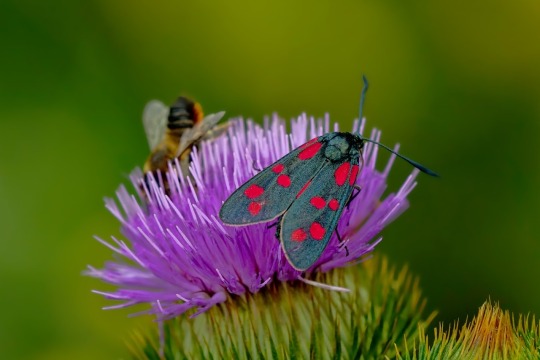
Six-spot burnet moth Zygaena filipendulae
A day-flying moth found commonly in meadows throughout Europe.
Image credit: Schwoaze on Pixabay
[image ID: a dark metallic green moth with six bisected red spots on the forewings resting on purple thistle flower with an unknown bee species in the background. The hind wings of the moth are hidden but a small glimpse of red is visible.]
#six spot burnet moth#zygaena filipendulae#moth#Schwoaze#lepidoptera#zygaenidae#zygaena#europe#image free from pixabay#insect
4 notes
·
View notes
Text

1 note
·
View note
Text

Six-spot Burnet Moth (Zygaena filipendulae), family Zygaenidae, France
Diurnal moth.
photographs by Philippe Leguet
503 notes
·
View notes
Text
Hazbin Hotel redesign ideas p. 1
Unfortunately I don't really have time to draw rn, but here are some ideas if anyone is looking for inspiration.
THE VEES:
They follow lates trends so they won't stick to the outfits and technologies from the times they died. We even see that Vox changed his screen (head) to more modern, flat TV screen.
Valentino:
He is a moth that realises poison that's basically a date-rape drug. His wings are hidden, looking like a coat, which makes no sense, a cloak, cape or sleeveless coat would look better. He is a pimp who died in 1970s. Val was Hispanic when living. Apparently, he has bad eyesight.

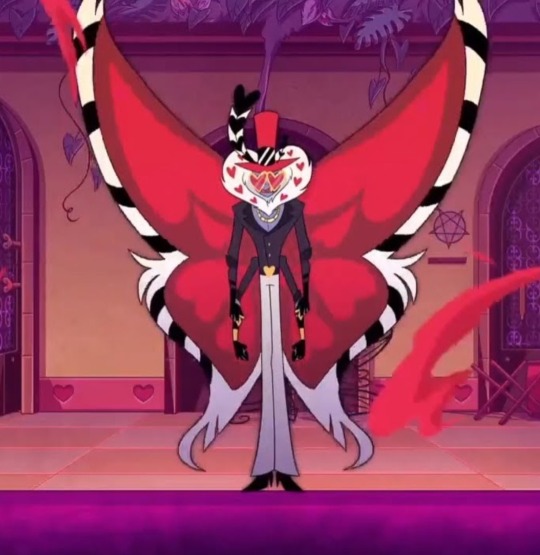
He is supposed to be a moth, but I don't really see it much, and the furr around his neck, that's a part of his body, just looks ridiculous. I would design him after some actual poisonous moth.
Cinnabar moth - The cinnabar is slate-black with two red spots and two pinky-red stripes on the rounded forewings. Its hindwings are pinky-red and bordered with black. The caterpillars feed on poisonous ragwort leaves. The poison from the leaves is stored in the caterpillar's body and remains even when they are an adult. As adult they leak the poison when they need to. Cinnabar moths can be seen flying during the day and night.



Six-spot burnet moth - day-flying moth that flies with a slow, fluttering pattern. It has glossy black, with six red spots on each narrow, but long forewing. They release hydrogen cyanide when attacked.

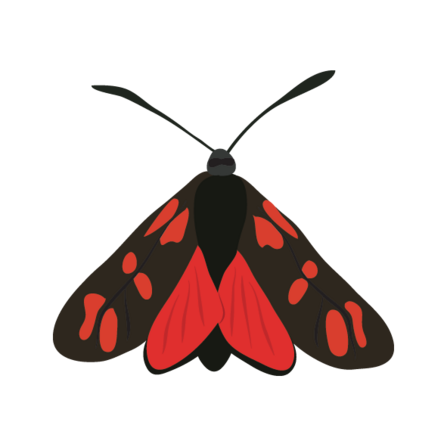
Personally I would go with Cinnabar moth, but make the spots heart shaped, and leave his inner outfit without the accessories (the suit with the white pants and golden heart belt). I would also leave his general body type but definitely change the neck furr ring, because wtf is that? I would play around with his glasses since he is supposed to have eyesight problems.
[Edit: Actually, I would make him a combo of both moths and make the furr ring his hair, because he is bald without the hat!?!?]
Velvette:
Velv is a fashion designer and critic, she is also an influencer. She keeps the Vees together and their image fresh on the internet. She's a British black woman in her early 30's. Originally her appearance was supposed to be doll-like, but that was changed to 'it-girl' and a 'bad bitch' with a darker aesthetic.

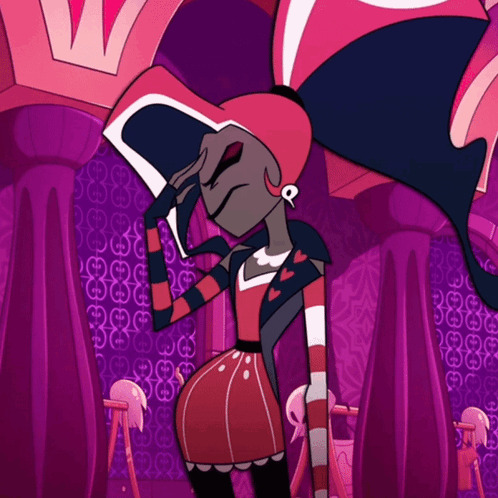
Velvette's outfit is reminiscent of Val's (heart belt, coat with hearts, black stripes on arms) but darker, especially her sleeveless coat that imitates his wings. Since Valentino is already going to be darker (in my idea) and she is a fashion influencer it would make more sense for her to be brighter.
Main thing I would change about her is her skin tone, hair, and Harley Quinn themes left from her old design.
When creating very human like characters it's important to actually get the racial characteristics right. Her ashy skin and "curly" hair just makes it look like they didn't know how to draw a black character. I would give her a different texture, something between 3A and 4B. A hairstyle like heart shaped space buns would be so cool, but even if not, her styl in a poster in the background is already better than the ponytails.
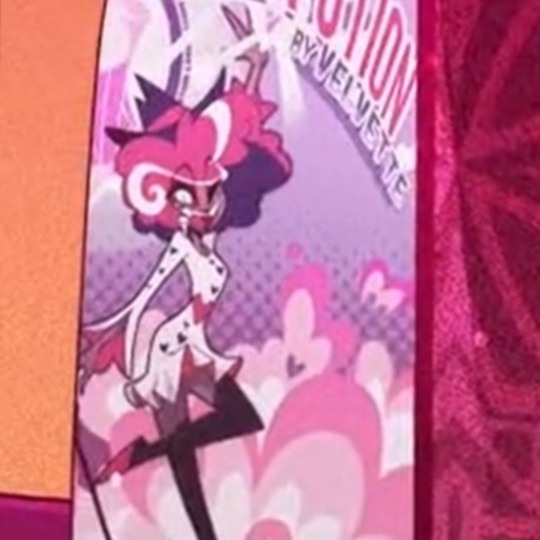
When it comes to her style I would get rid of pom-poms shoes and fingerless gloves. Her outfit for meeting the overlord was pretty okay, but I would change her other outfit. My inspiration would be PidginDoll's design, because he makes fabulous outfits and makeup looks for all bodies, genders and races, but I'll keep the 'goth' (it's not goth, it's just a little bit alt, mostly skulls) theme.
Blue accents like makeup would work great with her brown skin and would reference Vox.
Vox:
I genuinely think he has the best design in the entirety of the show, I would barely change anything. His outfit is similar to Alastor who he is trying to imitate, but he wears a tail suit, which is way more formal and elegant than any other suit, trying to showing he is a better, modern version of Alastor. I've seen some people got rid of his hat and gave him a tail made out a cord for fun, but other than that his design is good. Not too much details and not too little, tells us a lot about the character.
Maybe less stripes, because apparently Viv loves zebras or something. /hj
#hazbin hotel#hazbin hotel redesign#hazbin hotel criticism#hazbin hotel critical#the vees#hazbin hotel valentino#hazbin hotel velvette#hazbin hotel vox#hazbin hotel fanart
76 notes
·
View notes
Text
Moth of the Week
Nine-Spotted Moth
Amata phegea, formerly Syntomis phegea

The nine-spotted moth or the yellow belted burnet is a moth in the family Erebidae, the family of tiger moths. The species was first described in 1758 by Carl Linnaeus. The moths gets its names from the common nine spots on its wings and the yellow band on the sixth segment of its abdomen.
Description Both the moth’s body and wings are an iridescent blue on black or green on black. The wings usually have eight to nine white spots, six spots on the forewings and two or three spots on the hindwings. However the number and the size of these spots can vary per moth. Finally, the moth’s body has its own yellow spot in the second segment of the abdomen accompanied by a yellow band on the sixth segment. The antennae are thin black wires with white tips, unlike most moths’ antennae which are fluffy or saw edged.
Average wingspan of 37.5 mm (≈1.5 in)
Males are smaller than females and have thicker antennae.
Diet and Habitat The nine-spotted moth caterpillars eat many herbaceous plants such as bedstraws, dandelions, docks, fleaworts, grasses, and other low plants. This species is mainly found in southern Europe but makes appearances in northern Germany, Anatolia, the Caucasus, and the Dutch nature reserves of Leudal and Meinweg. It does not breed in the United Kingdom, but does immigrate there on rare occasions. They prefer drier areas such as open ranges with shrubs and trees, open forests, and sunny slopes.
Mating Adult moths mate in late May to August depending on location. Sources vary as to whether this species has one or three generations a year. Females lay an average of 104 eggs on host plants in groups of up to 61 eggs.
Predators The nine-spotted moth avoids predation by birds due to its mimicry of the Zygaena ephialtes. The Z. ephialtes is a moth unpalatable to birds, so its wings are brightly spotted to warn predators of toxicity. This is called aposematism.
Fun Fact The official term for the nine-spotted moth’s type of antennae is filiform, meaning thread-like. It is the most basic type of insect antennae.
(Source: Wikipedia, Moth Identification, CAB Direct, Amateur Entomologists’ Society)
#animals#bugs#facts#insects#libraryofmoths#moth#lepidoptera#mothoftheweek#Amata phegea#nine-spotted moth#yellow belted moth#Erebidae
176 notes
·
View notes
Text

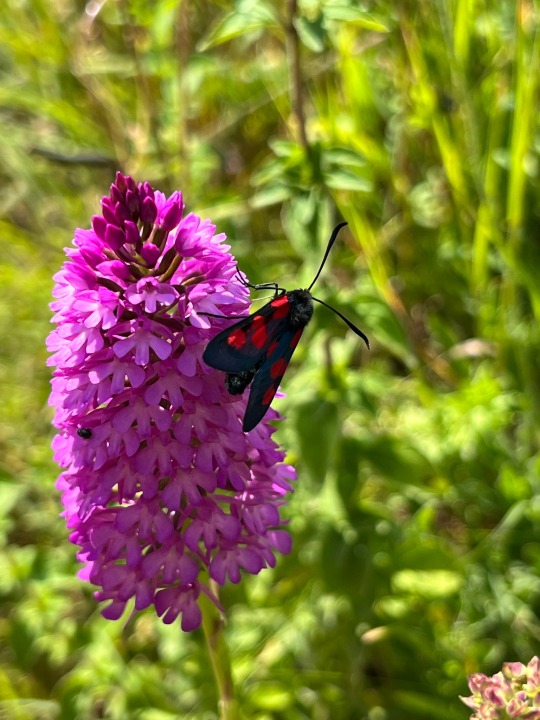
Six spot burnet moth on a wild orchid, South Downs, UK
(C) do not use, edit, reupload
#moth#Lepidoptera#uk moth species#uk insects#orchid#chalk upland#british wildlife#ghosti’s photography#non monster post
95 notes
·
View notes
Text




02/07/2024-Common Red Soldier beetles on wild carrot, dock and one of my first Six-spot Burnet moths of the year on creeping thistle which I was excited to see at Lakeside Country Park and tree out the front. Seeing the burnets reminded me of my fascination with them when seeing them at Lakeside in a summer where my butterfly passion was just beginning sparked my interest in moths.
Other highlights today included a few of the butterfly species I enjoyed seeing here in my early days interested in butterflies Marbled White, Ringlet and Meadow Brown, with Whitethroat, Moorhen, young Black-headed Gull, Grey Squirrel, oxtongue, tufted vetch, evening primroses, hogweed, self-heal which I really enjoyed seeing today and oxeye daisy also good to see.
#photography#birdwatching#six-spot burnet#walking#lunch time#tuesday#outdoors#happy#meadow brown#dock#creeping thistle#tree#hampshire#lakeside country park#england#uk#europe
2 notes
·
View notes
Text
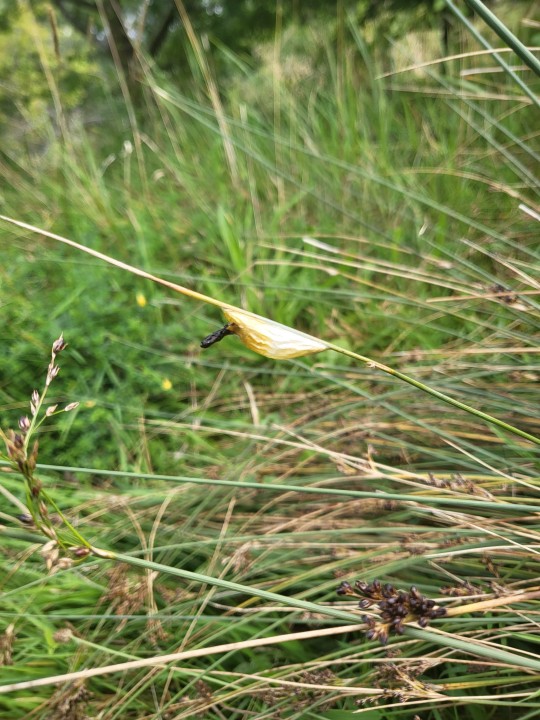
@sarnie-for-varney submitted: Found this pupa today (or at least I think it is). The most common butterflies we get around here at this time of year are gatekeepers, cabbage whites, and speckled woods. So I'm unsure what kind of creature could possibly emerge! Found in the West Midlands, England.
It's a moth cocoon actually rather than a butterfly chrysalis. I wouldn't be able to say which species exactly, but it's a burnet moth in the genus Zygaena. In your area the six-spot burnet would be the most common, so possibly that! The little black bit sticking out the top is the leftover caterpillar skin from when it molted into a pupa :)
43 notes
·
View notes
Photo

Book review: The Disappearance of Butterflies by Josef H. Reichholf
The cover of this book is a bit misleading, as it focuses on European butterflies and doesn't go into any detail about Monarchs, but I liked it. The author Josef Reichholf is a German entomologist that has been studying butterflies since the 1950s, and he knows what he’s talking about. The first part of the book examines the unique adaptations and habits of many species he’s studied, from aquatic moths to ermines to Six-spot Burnets. The latter part of the book details the primary causes of Lepidoptera population decline, and what needs to be done to reverse it. In his view, the largest contributor to the decline is overfertilization in agriculture followed by pesticide use, not urban sprawl or climate change. His studies actually show that cities can be sanctuaries for many species compared to the countryside due to it’s more structured layout than today’s modern farms and the comparatively low use of fertilizers and pesticides there.
#the disappearance of butterflies#Josef h. reichholf#non-fiction#butterflies#nature#conservation#book#bookblr#book review
29 notes
·
View notes
Text
Moth wings - strategies to avoid predation
Hide and seek (cryptic colouration) and/or hide and seek but I dress up as the thing I'm hiding on (Wasmannian mimicry)


Pictured: a peppered moth and a wave sphinx moth
'Yeah I'm poisonous, look at my scary bright colors' (aposematism) and/or 'Yeah I'm poisonous, I'm similarly coloured to another poisonous moth which you've eaten before so no need to eat me' (Mullerian mimicry)
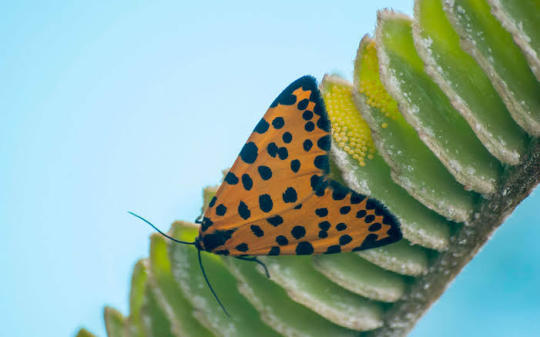

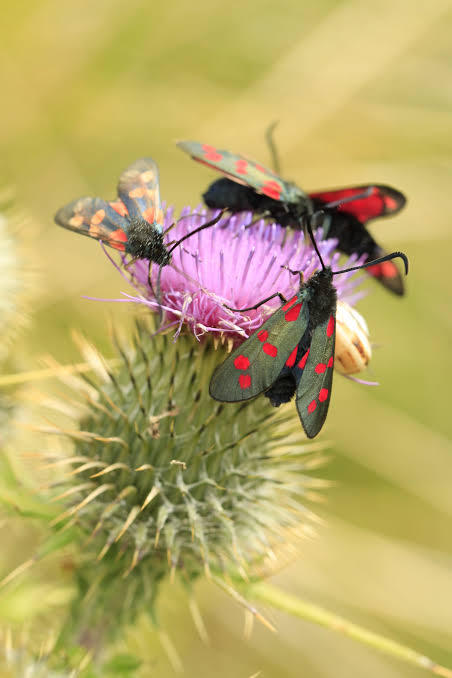
Pictured: a female leopard magpie moth, a garden tiger moth and several six-spot burnet moths
'Duh I'm poisonous!! I look like [insert other poisonous insect or animal], but please don't test your theory by biting me otherwise you'll find out I'm not actually poisonous' (Batesian mimicry)

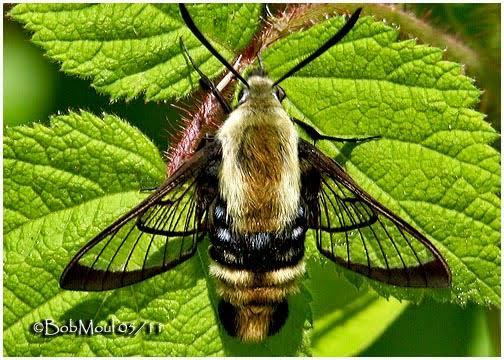

Included in the medley: a wasp mimic (male red oak clearwing), a bumblebee mimic (snowberry clearwing) and a spider mimic (a petrophila species)
Image sources:
Sidenote: I hate formatting posts on mobile eeghhhh
https://le.kloofconservancy.org.za/lockdown-an-opportunity-to-appreciate-your-local-biodiversity/
9 notes
·
View notes
Text
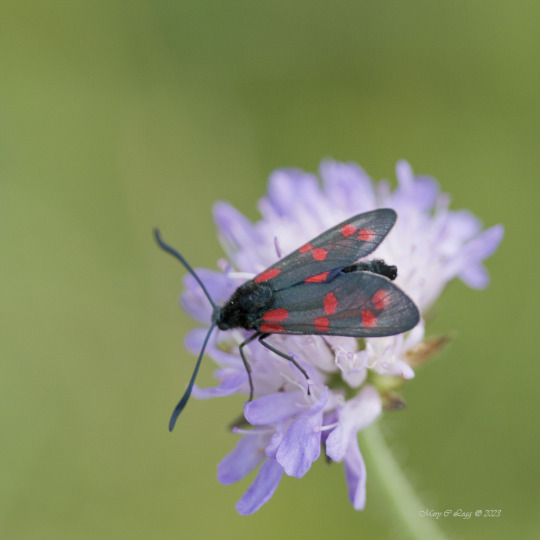
Six-spot Burnet, Zygaena filipendulae Canon 400D EF 100 2.8 f/2.8 1/500 iso: 200 Srbsko, Czech Republic 7/6/2008
7 notes
·
View notes
Text

Six-spot Burnet Moth (Zygaena filipendulae), family Zygaenidae, Bulgaria
Diurnal moth.
photographs by Айдън Асанов
291 notes
·
View notes